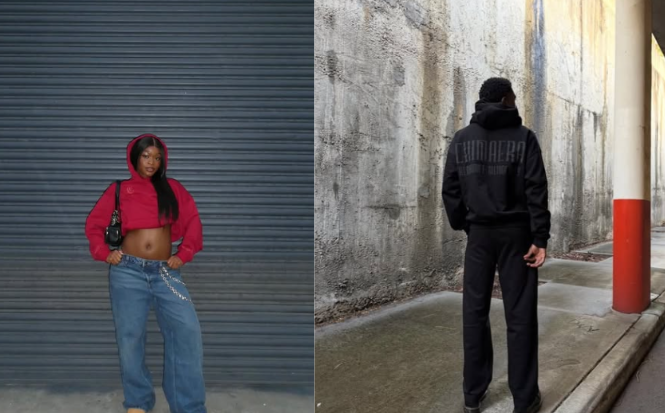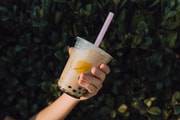
A tiny Australian fashion start-up has sparked a national debate that goes far beyond social media outrage.
Marie Efstratiou's defence of her Chimaera brand's refusal to stock larger sizes has ignited strong reactions—and forced the fashion industry to confront uncomfortable truths about inclusivity.
While some see it as a publicity stunt, the controversy has shone a light on systemic issues in Australian fashion that are harder to ignore.
At Australian Fashion Week 2025, just one per cent of models were plus-size—a stark reminder of how far behind Australia lags compared to international shows.
London Fashion Week in February 2025 featured 26 plus-size models, while New York Fashion Week included 23, highlighting a significant gap in representation.
This underrepresentation arrives as inclusive sizing and gender-neutral fashion gain traction, driven by social media trends and growing awareness of ethical and eco-friendly fashion choices.
'Fashion can bring so many more people in if they had that diversity in the first place'
The Australian fashion market tells a story of missed opportunities, valued at $23.90 billion in 2024 and projected to grow to $32.12 billion by 2034.
Consumers increasingly demand personalised products that reflect their personality, style, and occasion while seeking sustainable and ethically produced apparel.
Industry observers note the irony of Efstratiou's stance, as women's wear dominates the market thanks to high expenditure, fast-evolving trends, and diverse product offerings.
The economics of size-inclusive fashion
Starting a fashion brand with size-inclusive ranges requires larger initial investments in pattern-making and inventory.
Brands that embrace inclusivity often see stronger customer loyalty and word-of-mouth marketing.
The plus-size fashion market represents billions in untapped revenue for Australian brands willing to serve these customers properly.
Chimaera's controversy has highlighted how the conversation around inclusivity has shifted.
Fashion insiders observed that last year's Australian Fashion Week, while still lacking, had slightly better representation than 2025, with most shows including at least one plus-size model compared to only three shows this year.
Brands like Nicol & Ford are praised for diversity in race, size, and sexuality, including trans models, proving that Australian fashion can do better when it chooses to.
The contrast is stark: some brands lead with inclusion, while others resist consumer expectations and market demand.
Online shopping is reshaping Australian retail, expected to account for 46 per cent of all apparel sales by 2026, offering broader access to inclusive brands.
For shoppers over 60, this shift provides both opportunities and challenges, requiring navigation through a complex marketplace of brand values.
Australians consume an average of 27 kilograms of new clothing per year, making the country the second-largest per-capita consumer of textiles globally after the United States.
What this means for Australian shoppers
- Size inclusivity is becoming a competitive advantage for forward-thinking brands
- Consumer demand is driving change faster than some brands can adapt
- Your shopping choices directly influence which brands succeed and fail
- Online shopping expands access to inclusive brands beyond local options
Efstratiou defended her policy on health grounds, but industry experts have criticised this logic.
A plus-size model noted, 'I feel like if you can nail that part of the supply chain, then I think it would have an effect to everything else in terms of size diversity.'
Her response to a muscular customer, 'Nah keep the bulk son you good,' revealed inconsistencies in her health-based reasoning.
Technological advances are transforming fashion, with AI recommendations, virtual try-ons, and data-driven personalisation making size inclusivity more achievable.
Brands can now better predict demand, reduce waste with made-to-order systems, and understand customer needs more deeply.
Did you know?
Did you know? Australia confines approximately 800,000 tonnes of textiles to landfill each year, but consumers increasingly seek ethical, eco-friendly, and transparent brands using organic, recycled, or biodegradable materials.
The future of fashion belongs to brands that offer representation, sustainability, and alignment with consumer values, with Indigenous designers, environmental responsibility, and tech integration leading the way.
Chimaera's backlash demonstrates that consumers will no longer accept exclusion quietly, and in a market projected to reach $28.1 billion, brands excluding entire customer groups are taking a risky business gamble.
The power to shape the fashion industry's future sits in your wardrobe choices, with every purchase acting as a vote for the kind of fashion you want to support.
What This Means For You
Australian Fashion Week 2025 highlighted a glaring issue, with just one per cent of models representing plus-size bodies.
This underrepresentation is not only a reflection of the industry’s slow progress but also a missed opportunity, as size-inclusive fashion has been shown to build strong consumer loyalty and unlock significant untapped revenue.
The rise of online shopping further expands access to diverse and inclusive brands, giving Australians the chance to find clothing that truly fits and represents them.
Technological advances, from AI recommendations to made-to-order systems, make achieving size inclusivity more realistic for forward-thinking brands.
For shoppers, this means your choices matter—supporting inclusive brands helps push the industry toward a fashion landscape that represents every body, makes shopping easier, and rewards businesses that embrace diversity.
If you want to see a real-life example of how fashion choices can send a powerful message, there’s a story that highlights this perfectly.
It follows a single mum using clothing to promote body positivity and challenge conventional standards.
This piece shows how individual actions can make a big impact on representation and inclusivity in everyday fashion.
Read more: Single mum shares messages of body positivity through Kmart dresses
Aussie fashion brand faces backlash after defending refusal to stock plus sizes — Reports on Marie Efstratiou and her Chimaera brand’s controversial stance on excluding larger sizes.
https://www.dailymail.co.uk/tvshowbiz/article-15218483/Aussie-fashion-brand-backlash-defending-refusal-stock-plus-sizes.html?ns_mchannel=rss&ns_campaign=1490&ito=1490
Australian Fashion Week 2025: Where Is The Size Diversity?! — Highlights that only one per cent of models at Australian Fashion Week 2025 were plus-size.
https://www.pedestrian.tv/culture/australian-fashion-week-2025-size-diversity/
Australian Fashion Week 2025: Where Is The Size Diversity?! — Notes London Fashion Week had 26 plus-size models and New York Fashion Week had 23 in February 2025.
https://www.pedestrian.tv/culture/australian-fashion-week-2025-size-diversity/
Australia Clothing Market Set to Expand Significantly by 2034, Growth Opportunities and Trends Across Key Segments — Reports inclusive sizing and gender-neutral fashion are gaining traction in the Australian market.
https://www.einpresswire.com/article/794865020/australia-clothing-market-set-to-expand-significantly-by-2034-growth-opportunities-and-trends-across-key-segments
Australia Apparel Market Size, Trends, Growth | Report 2034 — Discusses the market being driven by changing fashion trends and growing awareness of eco-friendly, ethical fashion choices.
https://www.expertmarketresearch.com/reports/australia-apparel-market
Australia Clothing Market Set to Reach USD 32.12 billion by 2034 with 3% CAGR: Driven by Increase in Inbound Medical Travel — States the market was valued at $23.90 billion in 2024 and projected to grow to $32.12 billion by 2034.
https://icrowdnewswire.com/2025/05/15/australia-clothing-market-set-to-reach-usd-32-12-billion-by-2034-with-3-cagr-driven-by-increase-in-inbound-medical-travel/
Fashion and Apparel Statistics in Australia 2024 | Commission Factory — Highlights consumers’ desire for customised products that reflect personality, style, and occasion.
https://blog.commissionfactory.com/ecommerce-marketing/fashion-and-apparel-statistics-in-australia-2024-commission-factory
Apparel—Australia | Statista Market Forecast — Reports Australian consumers are increasingly seeking eco-friendly and ethically produced apparel.
https://www.statista.com/outlook/cmo/apparel/australia
Australia Clothing Market Set to Reach USD 32.12 billion by 2034 with 3% CAGR: Driven by Increase in Inbound Medical Travel — Notes women’s wear dominates the market due to high expenditure and diverse product offerings.
https://icrowdnewswire.com/2025/05/15/australia-clothing-market-set-to-reach-usd-32-12-billion-by-2034-with-3-cagr-driven-by-increase-in-inbound-medical-travel/
Australian Fashion Week 2025: Where Is The Size Diversity?! — Observers noted last year’s Fashion Week had slightly better size representation than 2025.
https://www.pedestrian.tv/culture/australian-fashion-week-2025-size-diversity/
Australian Fashion Week 2025: Where Is The Size Diversity?! — Praises Nicol & Ford for diversity in race, size, and sexuality, including trans models.
https://www.pedestrian.tv/culture/australian-fashion-week-2025-size-diversity/
Fashion and Apparel Statistics in Australia 2024 | Commission Factory — Projects online stores will account for 46 per cent of all apparel sales by 2026.
https://blog.commissionfactory.com/ecommerce-marketing/fashion-and-apparel-statistics-in-australia-2024-commission-factory
Fashion and Apparel Statistics in Australia 2024 | Commission Factory — Notes Australians consume an average of 27 kilograms of new clothing per year.
https://blog.commissionfactory.com/ecommerce-marketing/fashion-and-apparel-statistics-in-australia-2024-commission-factory
Australian Fashion Week 2025: Where Is The Size Diversity?! — A plus-size model highlighted manufacturing as key to improving size diversity.
https://www.pedestrian.tv/culture/australian-fashion-week-2025-size-diversity/
Australia Clothing Market Set to Expand Significantly by 2034, Growth Opportunities and Trends Across Key Segments — Explains adoption of AI, virtual try-ons, and data-driven personalisation is transforming the fashion industry.
https://www.einpresswire.com/article/794865020/australia-clothing-market-set-to-expand-significantly-by-2034-growth-opportunities-and-trends-across-key-segments
Fashion and Apparel Statistics in Australia 2024 | Commission Factory — Reports Australia confines approximately 800,000 tonnes of textiles to landfill annually, driving demand for eco-friendly and transparent brands.
https://blog.commissionfactory.com/ecommerce-marketing/fashion-and-apparel-statistics-in-australia-2024-commission-factory
Key Stats and Insights on the Australian Fashion Industry — Highlights Indigenous designers, environmental responsibility, and tech integration shaping a forward-thinking fashion industry.
https://www.worldfashionexchange.com/blog/key-stats-and-insights-on-the-australian-fashion-industry/
IBISWorld—Industry Market Research, Reports, and Statistics — Projects industry revenue of $28.1 billion, including an anticipated 8.3 per cent fall in 2024-25.
https://www.ibisworld.com/australia/industry/clothing-retailing/407/
What brands have impressed you with their inclusive approach to sizing and diverse representation?







